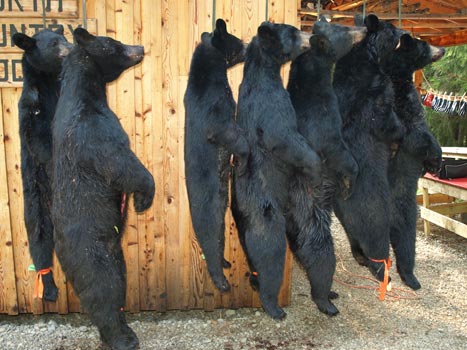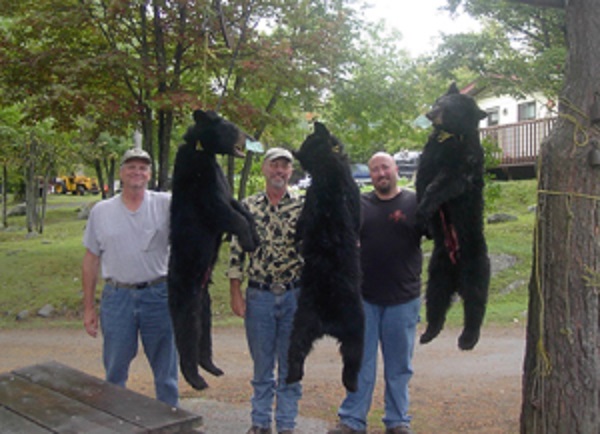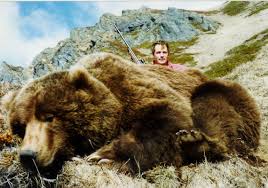
Bear hunting has long been a controversial issue in North America. While some consider it a traditional and recreational activity, others argue that it is ethically and environmentally unacceptable. As bear populations and their habitats face increasing threats, it is critical to consider sustainable alternatives to hunting. This article provides an overview of the controversies surrounding bear hunting in North America, its environmental and ecological impacts, as well as ethical considerations. We will explore various alternatives to bear hunting and their potential economic benefits, while emphasizing the importance of promoting coexistence and education between humans and bears. Through collaborative efforts and sustainable solutions, we can make a difference for the survival and well-being of bears and their ecosystems.
Introduction to the Controversial Bear Hunts in North America
Bear hunting has been a contentious issue in North America for decades, with conflicting perspectives on the practice. Proponents argue that it helps control bear populations, is an important cultural tradition, and provides recreational opportunities for hunters. However, others believe that hunting bears is unethical, environmentally damaging, and not an effective method for population control. This article will explore the controversies surrounding bear hunting in North America and suggest alternative approaches to promote coexistence with these magnificent creatures.
Overview of Bear Hunting Practices in North America
Different regions of North America have varying regulations and practices when it comes to bear hunting. For example, in some U.S. states, bears can be hunted with a license during specific seasons, while in others, hunting is prohibited altogether. In areas where hunting is allowed, methods can include baiting, hounding, and using dogs to track or tree bears.
Controversies and Public Outcry Against Bear Hunting
Despite being legal in many places, bear hunting has faced significant opposition from animal welfare advocates, conservationists, and the public. Many people argue that hunting bears is cruel and inhumane, with animals suffering excruciating pain and fear. Additionally, there are concerns that hunting disrupts delicate ecosystems, impacts biodiversity, and has no significant impact on population control. As a result, there have been frequent calls to ban bear hunting altogether.
Environmental and Ecological Impacts of Bear Hunting
Effects on Bear Populations and Dynamics
The impact of bear hunting on bear populations and dynamics is complex and not well understood. While hunting could reduce the population of bears in a particular area, it can also disrupt social structures and affect the age and sex ratio of bears in the population. Additionally, research suggests that hunting can lead to a higher prevalence of problem bears, as hunting targets the larger and more dominant individuals, leaving behind weaker bears who may rely on garbage or other human food sources.
Impact on Ecosystems and Biodiversity
Bears play a crucial role in maintaining healthy ecosystems, acting as seed dispersers, and controlling prey populations. Bear hunting can disrupt these ecological functions and cause cascading effects throughout entire ecosystems. Additionally, research suggests that bear hunting can also lead to declines in other animal populations that rely on the same ecological resources as bears, cascading into a wide range of other ecological impacts.
Ethical Issues Surrounding Bear Hunting
Moral Considerations and Animal Welfare
The ethical considerations of bear hunting include moral and value-based arguments about the rights and welfare of animals. Many people argue that hunting bears is cruel and inhumane, with animals suffering from prolonged pain and fear. Furthermore, there are concerns that hunting is an unnecessary activity that perpetuates a cycle of violence against animals.
Traditional versus Recreational Bear Hunting
Another ethical consideration is the difference between traditional versus recreational bear hunting. Traditional hunting practices, such as those practiced by Indigenous communities, are deeply ingrained in cultural and spiritual practices and are often conducted with a deep reverence for the animal. In contrast, recreational hunting is often viewed as a leisure activity and may not have the same cultural and spiritual significance.
Alternatives to Bear Hunting: Promoting Coexistence and Education
Bear Deterrents and Non-Lethal Management Approaches
There are many alternative approaches to bear hunting that prioritize coexistence and non-lethal management strategies. Bear deterrents, such as electric fences and bear-resistant containers, can help reduce human-bear conflicts and protect public safety without resorting to lethal measures. Additionally, programs that focus on moving problem bears to appropriate habitats or reducing human-bear interactions can be effective in managing bear populations.
Education and Outreach Programs for Communities and Visitors
Education and outreach programs can also play a significant role in promoting coexistence with bears. Programs that teach communities about bear behavior and ecology can help reduce conflict and increase understanding of the importance of maintaining healthy bear populations. Additionally, outreach programs for visitors can raise awareness about bear safety and encourage responsible interactions with wild animals.
In conclusion, the controversies surrounding bear hunting in North America are complex, with conflicting perspectives on the practice. While hunting may be legal in many areas, it is not without environmental, ethical, and ecological impacts. As such, it is important to consider alternative approaches that prioritize coexistence and non-lethal management strategies. By doing so, we can promote responsible and sustainable interactions with these magnificent creatures and ensure that they remain an integral part of our ecosystems for generations to come.
Economic Benefits of Alternatives to Bear Hunting
Bear hunting has long been a controversial issue in North America. While some argue that it is necessary to control bear populations, others believe that hunting these magnificent creatures is simply cruel and unnecessary. However, there are alternatives to bear hunting that not only benefit the bears, but also provide economic benefits to communities.
Tourism and Recreational Activities
One alternative to bear hunting is promoting eco-tourism and recreational activities such as bear watching or hiking. Many people are willing to pay to see bears in their natural habitat and learn about their behaviors and habitats. This can bring in significant revenue for local communities through the sale of permits, lodging, and other related services.
Implementation and Maintenance Costs
While introducing sustainable solutions may initially come with implementation and maintenance costs, they can ultimately result in significant cost savings compared to bear hunting. Providing safe habitats and guiding tourists to see bears in their natural settings is much more economical than the costs of managing a hunting program, which includes enforcement, education, and management.
Conclusion: Making a Difference Through Sustainable Solutions
The Importance of Collaboration and Advocacy
In order to promote sustainable solutions to bear hunting, collaboration and advocacy among communities, government agencies, and conservation organizations is crucial. This requires a collective effort to educate the public on the benefits of sustainable solutions and the negative impacts of bear hunting.
Benefits of Sustainable Solutions for Bears, People, and the Environment
Sustainable solutions not only benefit the bears, but also the people and the environment. By protecting bears and their habitats, we are also preserving our natural resources and biodiversity. Furthermore, sustainable solutions provide economic benefits to local communities, which can help support long-term conservation efforts. Ultimately, it is up to all of us to work together to find sustainable solutions that benefit us all.In conclusion, we need to promote responsible bear management practices that prioritize the well-being of bears and their habitats, while considering the interests of humans. Alternatives to bear hunting such as bear deterrents and education programs can be effective and sustainable solutions. With continued efforts to promote coexistence and conservation, we can ensure a future where bears can thrive in their natural habitats and enrich our lives in countless ways.
Frequently Asked Questions (FAQ)
Why is bear hunting controversial?
Bear hunting is controversial for a variety of reasons, but the main concerns are the ethical and environmental impacts of the practice. Many people view hunting as an unnecessary and cruel form of recreation, while others argue that it is a traditional activity that contributes to wildlife management. Additionally, bear hunting can have significant impacts on ecosystems and bear populations, leading to long-lasting consequences.
What are some alternatives to bear hunting?
There are several alternatives to bear hunting that can promote coexistence and conservation. Non-lethal management approaches such as bear deterrents, relocation, and habitat protection can be effective in managing bear populations and reducing human-wildlife conflicts. Additionally, education and outreach programs can help communities and visitors understand the importance of bears and the need for sustainable solutions.
What are the economic benefits of alternatives to bear hunting?
Alternatives to bear hunting can provide significant economic benefits, such as promoting tourism and recreational activities. Wildlife watching, eco-tourism, and other nature-based activities can generate revenue for local communities and support conservation efforts. Additionally, sustainable approaches to bear management can lead to long-term economic benefits by preserving the natural resources and ecosystems that support human well-being.
How can I get involved in promoting sustainable bear management?
There are several ways to get involved in promoting sustainable bear management, including supporting conservation organizations, volunteering for education and outreach programs, and advocating for non-lethal management approaches. By raising awareness about the importance of bears and their habitats, you can help create a future where humans and bears can coexist in harmony.
_____________________
Native American Bear Meaning:
Sybolic Wisdom from the Bear
When we walk the Path with the bear, this animal will inevitably tell us about its long history with the First People of North America.
As a Native American symbol, the bear is as free in spirit as the great wind; and grander than its mass. To match that magnitude is the quality of unpredictability in the bear. A massive animal who forages seemingly peacefully in the woods on berries and bush. when provoked in certain ways, the First Peoples witnessed a ferocity expressed from the bear that (understandably) could elicited terror.
Because of this potentially furious storm brewing just under the surface of bears spirit, our native forebears were extremely cautious and respectful of this animal. Even tribes inclined to peace honored the spirit of a warrior, and witnessing the bear seemed to embody that kind of blind, powerful surge of courage and strength that every warrior is want to tap into.
Bear meanings were enhanced by observations made tribal sages. These vital tribal figures were inclined to pensive and deeper understanding of how nature communicated intent in all her forms. These sages found connections between human and beast and from these associations would interpret profound meanings that propelled the community into direction, action, and wisdom.
One such connection to bear meaning comes from a Shoshone sage who, set about bridging worlds in a manner of trance walking. During his trance walk, he was gifted with the site of a clan of bears who were performing what seemed to be a ritual dance.
These were not spirit bears, but real bears, on their hind legs, dancing in the golden rays of the sun. The Shoshone sage understood this to be a dance of gratitude as well as a prayer for the healing and protection of their young. From that point further the Shoshone have instigated their own Sun Dance where the bear is a central figure of the ritual symbolizing protection, strength and continuation of the progeny of the tribe.
Native American Bear Meaning and Symbolism
Power
Courage
Freedom
Protection
Motherhood
Discernment
Childbearing
Resourcefulness
Unpredictability
We see a lot of connections with bear and man in the Native mind. We can intuit these bear meanings to come from the human-like appearance of the bear when it's posed on hind legs. Further, the natives observed the bear looks remarkably human when skinned of its fur.
Bear meanings of motherhood and child protection continue in the Aleut and Haida minds where legend indicates the bear would take a tribal woman as its wife. From this union, man and bear strengthened their greatest aspects, combining the best (and sometimes worst) traits.
As a Sioux symbol, the bear also has healing symbolism. Sioux legend indicates mother bear was weary from carrying her heavy babies in her belly. She was having trouble walking and feared she could not make the journey to the great foraging fields to feed during her final days of pregnancy. She rested against redwood sorrel plant and the plant spoke to her, telling her that if she ate of its leaves her body would be able to sustain her load. Mother bear did as the sorrel advised to discover the treatment worked. She knew her Sioux sisters would have the same troubles when they were heavy with their own babies, so she shared the medicinal advice with the Sioux medicine woman.
The bear is a strong Native American symbol to the Cree who are powerfully connected with the bear. Recognizing its girth, and amazingly effective teeth and claws, the Cree adopted the bear as a symbol for successful hunt. Intricate preparations were made prior to a hunt. These preparations featured the bear as the guest of honor. Every aspect of pre-hunting ritual was designed to honor the bear. Even after the ritual bear skulls would hang in the lodge overnight to induce dreams of bears that provided good luck in the hunt. That is, if the bear was pleased, the dreams would come, and the hunt would be a success.
Above all, bear meaning holds incredible influence and magnitude to the North American tribes. And although the bear is a profound Native American symbol of majesty, freedom and power it is far more. The spiritual connections made with the bear makes it a brother to the First People.
As a brother, the bear imparts this advice to both our ancestors and us today...
Native Wisdom the Bear Imparts to Us
Because the bear is cautious, it encourages discernment to humankind.
Because of a fierce spirit, the bear signals bravery to those who require it.
Because of its mass and physical power, the bear stands for confidence and victory.
Because it prefers peace and tranquility (in spite of its size), Bear calls for harmony and balance.

I have much more to come. Please share if you know where I can get more content ... Thanks


